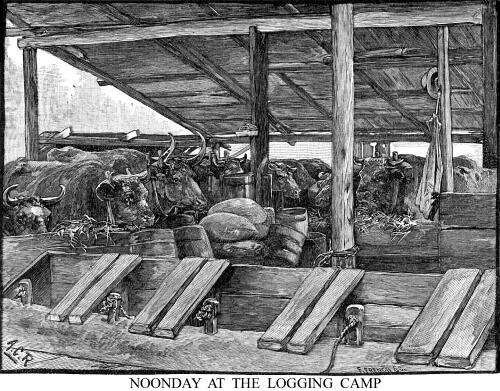 IN A REDWOOD LOGGING CAMP IN A REDWOOD LOGGING CAMP
Harper's Monthly—1882
ALL forest trees show a tendency to dispose themselves in groups
or in strata. The usual cause, or at any rate a coincident of
this, is the lithological character of the region where they grow,
or else it is a matter of altitude. Thus in mountains you may
see a regular stratification of trees from the base to timber-line.
The case of the Californian redwoods of both species is a very
marked one in respect to this characteristic. The "big trees"
proper (Sequoia gigantea) are confined to certain groves
on the western flank of the Sierra Nevada, whose boundaries are
well known, and where even the individual trees have been counted
in some cases. The other species, distinguished by the name "redwood"
(S. sempervirens), is confined to that portion of the Coast
Range between Santa Cruz and the northern line of California—a
narrow belt about three hundred miles in length, which is said
to be defined strictly by the outcropping of the metamorphic limestones
left more or less uncovered by the lava currents from the coast
volcanoes of former days.
The general history of the sequoias (the name is a compliment
to that enlightened chief who first reduced the Cherokee language
to writing) need not be retold here with much detail. The genus
is coniferous, and is more nearly related to the cypresses than
anything else, but its allies are scattered—one in Japan,
one in the Himalayas, and another in the Gulf States of America,
all reaching unusual stature. It is a group remarkable for its
antiquity, too, remaining as the representative of almost the
earliest period when trees grew upon the earth.
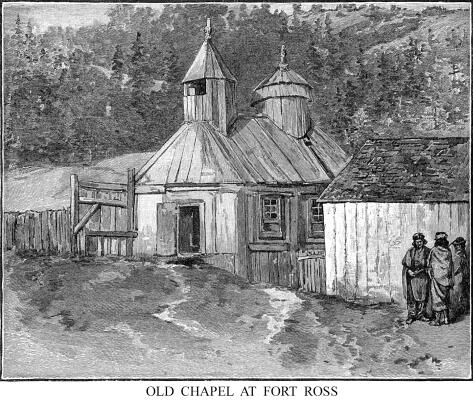 The redwoods in this coast belt
stand in an unbroken forest along the base of the range—a
forest whose height you appreciate only when you note how low
a cleared hill seems beside its wooded fellows. It is difficult
when in the forest to understand how tall the trees really are,
since the spruces, etc., with which they are associated are far
beyond the ordinary, and there is nothing to guide the eye. Where
the redwoods grow, heavy fogs roll in from the Pacific during
all the rainless months. Entangled in the dense and clustering
foliage of the tall and crowded trees, they are condensed by the
cool air which is held in the pockets of shade under the matted
twigs and needles, and fall in misty showers, constantly refreshing
the soil. Thus it happens that the redwood forests are particularly
rich in a great variety of other trees and bushes; and a perfect
jungle of undergrowth, shrub-like and herbaceous, flourishes there,
among the rest vast quantities of poisonous plants (especially
rhus), so that it is the worst of places for any person to go
a-rambling who is susceptible to harm from that source. The redwoods in this coast belt
stand in an unbroken forest along the base of the range—a
forest whose height you appreciate only when you note how low
a cleared hill seems beside its wooded fellows. It is difficult
when in the forest to understand how tall the trees really are,
since the spruces, etc., with which they are associated are far
beyond the ordinary, and there is nothing to guide the eye. Where
the redwoods grow, heavy fogs roll in from the Pacific during
all the rainless months. Entangled in the dense and clustering
foliage of the tall and crowded trees, they are condensed by the
cool air which is held in the pockets of shade under the matted
twigs and needles, and fall in misty showers, constantly refreshing
the soil. Thus it happens that the redwood forests are particularly
rich in a great variety of other trees and bushes; and a perfect
jungle of undergrowth, shrub-like and herbaceous, flourishes there,
among the rest vast quantities of poisonous plants (especially
rhus), so that it is the worst of places for any person to go
a-rambling who is susceptible to harm from that source.
The trunks of all the coniferous trees, and especially of the
sequoias, stand as straight as though turned in a lathe and set
by a plummet, rising usually a great distance without large limbs,
but sometimes hirsute with stubby boughs spirally attached all
the way down. In specimens of healthy growth and sound heart the
stem tapers gently to a stiff though slender top spray; but in
the majority of trees you will see no tapering top, but a sudden
squaring off, which looks like a deformity, and which the chopper
will tell you betokens an unsound trunk.
Again they will bend off at right angles into a plume-like
branch, which is a deformity. In windy places, like the exposed
sea-front, all the boughs are twisted into a single plane landward,
and great picturesqueness results; but it is always a stiff, motionless,
statuesque picture, in the darkest tone foliage can assume, for
there is nothing wavy or pliant anywhere from root to topmost
leaf.
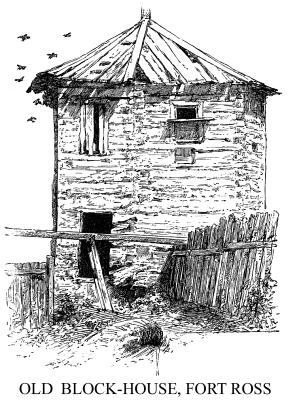 Such were the stern autochthonous
trees whose downfall, at the hands of the lumbermen, we went up
from San Francisco to witness. Such were the stern autochthonous
trees whose downfall, at the hands of the lumbermen, we went up
from San Francisco to witness.
Fully a century ago the pleasant vales leading up into the
Coast mountains had been penetrated by the frontiersmen of Mexico,
of which country this whole great region was an ill-defined province
under the name of Alta California. These men were herdsmen or
farmers. Early in the present century a colony of Russians and
Indians from Alaska, under the leadership of Alexander Koskoff,
landed at Bodega Bay, and began farming where now is the village
of Bodega. Not satisfied with this place alone, however, they
travelled northward some forty miles, and established a permanent
trading post and agricultural station near Salt Point, the site
and many of the buildings of which are now occupied as the village
of Fort Ross—an anglicized abbreviation of Fuerte de los
Rusos, as the post was called by the Spaniards.
The occupancy of this strip of coast—for their hold extended
all the way between Point Arenas on the north and Point Ruges
on the south—by the Muscovites from 1811 until 1840, when
they abandoned their station, left its impress upon the names
of the region, and especially clings to the principal stream watering
this portion of the redwood belt—the Russian River.
This river, which flows southward from sources close to the
foot of Mount Shasta, turns suddenly to the west, forces its way
through the Coast Range, and pours a swift flood into the Pacific—a
matter of ambition to the stream, perhaps, but of not the slightest
moment to the ocean, which does its best, in fact, to prevent
the sacrifice. Seven miles above the mouth of the river, just
where it escapes from the clutch of the hills and the forest,
stands the two small settlements of Moscow and Duncan's. Both
owe their existence to the presence of mills, and from each small
branch railways run back into the forest for the purpose of bringing
out the logs. Duncan's, on the northern bank of the river, is
the terminus of the North Pacific Coast Railway, and there we
took up our quarters, a very comfortable hotel furnishing us bed
and board.
Before we went back into the woods, however, circumstances
and the tender of good horses led us to some excursions which
taught us "the lay of the land," and enriched our sketch-books
with some notes worth telling.
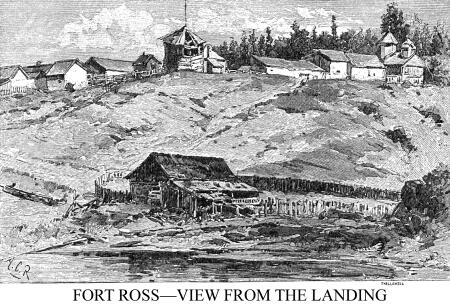 Upon the high hill west of Duncan's
stand splendid groves of varied trees, accented by thickets of
the red-limbed madroña. Between lie open spaces of lush
pasture, where cattle and horses loiter with contented eyes and
rounded bellies. Upon the high hill west of Duncan's
stand splendid groves of varied trees, accented by thickets of
the red-limbed madroña. Between lie open spaces of lush
pasture, where cattle and horses loiter with contented eyes and
rounded bellies.
"The men who own these uplands," said our neighbor,
"live like lords—at least in respect to their lack of
care. They buy calves when a few weeks old, adding to the produce
of their own herds, turn them out, and never see them again till
the butcher calls to buy beef. Right here," he added—with
an appropriateness to place rather than talk—"three
of us last spring tried to head off a single man who had just
robbed the stage at the foot of the hill; but as he was coming
up the gully there," pointing to a densely thicketed ravine,
"something told him he ought to run. He crossed this open
space, and was just in the edge of those woods when we came up.
He got away that time, but a few months after he was caught on
another charge, and proved to be notorious as a road agent."
A sudden escape from curtaining oak branches brought us full
upon the summit, where the other side fell away precipice-like,
but unbrokenly turfed, and there before us was all the grand expanse
of the Pacific, the fretting of its surf coming as a continuous,
far-away deep music,
"Like the great chords of a harp in
loud and solemn vibrations."
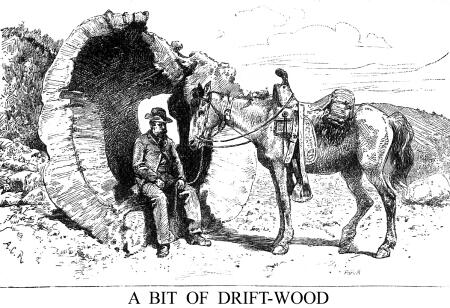 But the shore was miles away,
and its high horizon, rising to meet our point of view, made the
interspace seem the deeper. Through this interspace, avoiding
skillfully the, protruding headlands pushed out by the opposite
hills to try what dovetailing would do toward stopping its course,
wound the double S of the river. But the shore was miles away,
and its high horizon, rising to meet our point of view, made the
interspace seem the deeper. Through this interspace, avoiding
skillfully the, protruding headlands pushed out by the opposite
hills to try what dovetailing would do toward stopping its course,
wound the double S of the river.
Hurling its current against the rock-faced piers of the hills
on this side and then on that, one bank always rising sheer from
the water, leaving the other low and flat, the elbows of its sinuous
course inclosed stretches of sand with coarse grass and willows,
marshy islands and shallows where herons fed, and wandering cormorants,
alighted to rest their paddles, half-submerged ledges of rocks,
and fertile areas of alluvial soil just above the reach of the
freshets. Never was seen such a collection of drift-wood as the
huge forest relics cast up here! I rode my horse up beside one
short hollow log, high and dry on the beach, and could not look
over its top as I stood in my stirrups. Its interior would have
sheltered a picnic party.
All the hills were free from woodland near the river, save
where occasional gullies sheltered thickets of small stuff, but
through the turf here and there protruded the rocky frame-work,
gray, splintered, and lichen-painted under the weather's hand.
It was all green then that lay before us, save the sinuous band
of blue river and its fringe of yellow sand-flats, but a green
mottled and blending with yellow and orange, red, purple, and
brown; a verdancy universal, yet nowhere uniform, broken, as a
whole, only by the blues of the sky and the changing sea and the
flashing stream, yet having as many expressions and touched with
hues as various as the different points upon which your eye might
rest. It was a landscape of the simplest elements—rounded
hills, a water-course, the sea, a cloudless arch,
"High over all the azure-circled earth"—
yet its quiet beauty was satisfying, with a charm far beyond
the reach of words to interpret.
Chiselled out of the steep hill-side, near the river-level,
the stage-road ran upon a sort of shelf, giving it lodgment where
otherwise not even a goat could have kept its foot-hold. Leading
our horses down to this road by a series of zigzags, crushing
sweet-fern and brilliant flowers under our feet at every step,
we followed it along the river toward the shore. Here and there
farm-houses and ploughed land were to be seen, but nearly all
the wide expanse of open uplands was devoted to pasturage, hundreds
of cattle being constantly in sight, gazing at us with frightened
eyes from the road-side, or crawling about like ants on the lofty
ridges. In several little nooks on the southern bank stood small
shanties, which were the homes of Indians and half-breeds—mongrels
left between the Diggers, who were natives of this region before
the whites came, and the Kodiaks or Russians. They cultivate small
tracts, and otherwise eke-out a contented existence by fishing
and working upon the ranches, chiefly as herders.
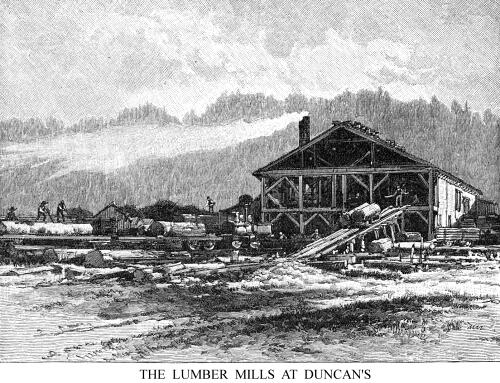 The cow, indeed, is the strong,
point of ranch industry here, and the only stables we saw were
intended for her. Turning in through a high swinging gate, past
a barn where the two species of resident swallows were quarrelling
loudly over rights of possession, we entered one of the dairy-houses.
There are a dozen or so of dairies about here, almost wholly in
the hands of Swiss people, and the butter they make is of the
most excellent kind, fragrant and yellow with the rich herbage
of the hills. The cows, nevertheless, are of ordinary stock, and
their owners profess contempt for the "fancy" breeds
as something very pretty to play with, but of no real value to
the farmer. Certain it is that these Swiss can get more milk out
of a scrub cow than any of their neighbors are able to. The cow, indeed, is the strong,
point of ranch industry here, and the only stables we saw were
intended for her. Turning in through a high swinging gate, past
a barn where the two species of resident swallows were quarrelling
loudly over rights of possession, we entered one of the dairy-houses.
There are a dozen or so of dairies about here, almost wholly in
the hands of Swiss people, and the butter they make is of the
most excellent kind, fragrant and yellow with the rich herbage
of the hills. The cows, nevertheless, are of ordinary stock, and
their owners profess contempt for the "fancy" breeds
as something very pretty to play with, but of no real value to
the farmer. Certain it is that these Swiss can get more milk out
of a scrub cow than any of their neighbors are able to.
This dairy was a small frame building of three rooms. In the
largest the pans were set upon racks against the wall, and kept
at the proper temperature. In a second room were water-heaters
and arrangements for washing pans, etc. The third room was a sort
of shed where the butter was made. Here, between two upright posts,
was hung upon trunnions a square pine box, like a Saratoga trunk,
so as to revolve with a rapidity depending upon the speed with
which a blindfolded pony in the neighboring yard walked around
the set of cogs that kept the gearing in motion. This box was
the churn, and we were just in time to get a dipperful of the
buttermilk, which was drawn off by pulling a plug in the bottom
when the butter had "come." We looked into the churn,
and saw it partly filled with a foamy mass of yellow granules
as rich as gold and fragrant as flowers. After this had been repeatedly
washed with spring water, the dairyman drew near to the churn
a heavy fan-shaped table, glistening with its cold bath. Here
was heaped the sixty or seventy pounds of sticky pellets, to be
"worked" under a stout roller-mallet until suitable
for market. This done to his satisfaction, the man took up a pair
of heavy brass calipers in whose jaws were fixed the two halves
of a cylindrical wooden mould, the length and calibre of which
shaped the size of the standard two-pound roll customary in this
market. One powerful grasp compressed into this mould all it would
hold; the surplus was cut off, the roll released and folded in
its cool linen wrapping, and it only remained to stand it on end
with the similar cylinders filling the shallow shipping case,
and to cart it away to the train. The whole operation was deft
and neat and genuine; and the heated gold broker at the Bohemian
Club tasted in his crisp mouthful next day all the subtle juices
of the herbs upon Sonoma hills.
The mouth of the river, when we had gone near enough to have
a good view of it from a headland, made a very noble picture.
The green hills on the south slope gradually to a well-turfed
base, hiding the beach, but showing a long sand-spit running out
almost across the very entrance of the little bay, behind which
are calm shallows. The northern headland, on the other hand, stands
in bold outline—a point of sheer cliff jutting between the
ocean and the river. Yet the charge of those waves rolling from
the spicy archipelagoes of the great South Sea, or from the bleak
coasts of Tartary, is met, not by this mole, but by an outer row
of gigantic isolated rocks, overtopping the tide as the stones
of Carnac rear their heads above the level plain, and the imagination
can easily believe some giant of old, more powerful than the Druids,
to have planted them there as a breakwater guarding the harbor.
Around their base curls the angry foam of swift-charging, impotent
breakers, and they glory in the snowy clouds of spray that envelop
their flanks, for thus the rage of the mightiest of oceans is
proved ineffectual, and the tamed waves sink behind them into
sullen peace upon the weedy shore.
Such was the broad landscape of the region where we cast our
lot these pleasant June days, and watched the cutting of the big
trees.
Tradition says that credit for the very first attempt to make
lumber with a saw in this region (for the Russians hewed all their
beams and planks) belongs to John Dawson, of Bodega. Dawson was
one of three sailors who abandoned their ship at San Francisco
as early as 1830, preferring the free and easy life of the Californians.
In two or three years they became citizens 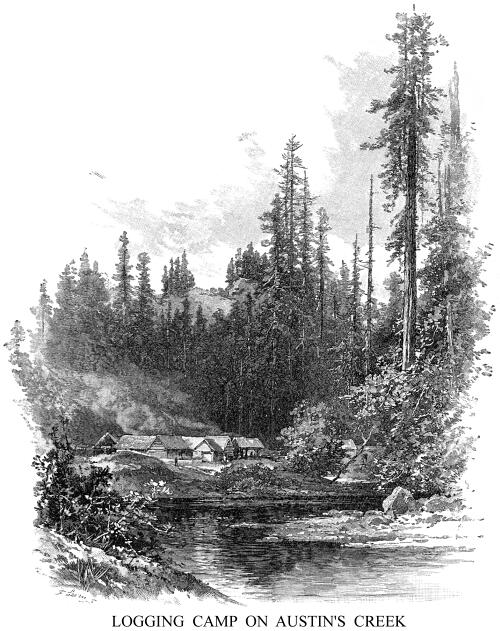 under
the Mexican government, and took up granted ranches hereaway,
Dawson marrying the daughter of a Spanish dragoon officer. She
was only fourteen when she went to live as mistress of the Cañada
de Pogolome, and only seventeen when she found herself the richest
widow in Northern California. Dawson's lumber was cut over pits
by means of a rip-saw, which he handled without help. Not half
a century later steam mills in this district are turning out two
hundred thousand feet of lumber daily. under
the Mexican government, and took up granted ranches hereaway,
Dawson marrying the daughter of a Spanish dragoon officer. She
was only fourteen when she went to live as mistress of the Cañada
de Pogolome, and only seventeen when she found herself the richest
widow in Northern California. Dawson's lumber was cut over pits
by means of a rip-saw, which he handled without help. Not half
a century later steam mills in this district are turning out two
hundred thousand feet of lumber daily.
The centre, or at least one centre, of this lumbering is here
at Duncan's, where the Russian River receives a tributary named
Austin's Creek. A wonderful railway follows its banks half a dozen
miles back into the hills to supply the mill with logs.
Never was seen so unshipshape and disreputable a locomotive
as that on duty here. A stubby black boiler, with a trifling amount
of upper gear, makes steam, turning four small wheels by means
of a cog underneath. There is no cab, or place to put one, no
pilot, head-light, or any other appurtenances of an ordinary locomotive,
and the wire bonnet of the smokestack is worn on one side with
such a "What-d'ye-soye ?" air that the smutty little
machine declares itself a very hoodlum among locomotives. Nevertheless,
it accomplishes wonderful feats of pulling.
Free of the load of logs brought down, it is going back in
the coolness of the early morning, and we go with it. The track
is of the usual gauge, but the cars are platforms of only half
the ordinary length, and are fastened together by ropes, shortened
up when the train is empty, but lengthened so as to separate loaded
cars by six or eight feet, in order that the protruding ends of
the logs shall not interfere.
The track is rudely built and rickety, the rails being heavy
strap-iron bolted upon string-pieces. It runs shakily through
tunnels of infinitely varied verdure, curves along ledges blasted
out of the brown and fern-hung rocks of the creek shore, traverses
low ground upon causeways of ties and stringers, each as big as
a hogshead, ventures out upon some precarious bracket-trestle
whence it might plunge directly into the stream. Almost from the
first we have entered the old forest, where (now that the choppers
have passed on) we revel in the beauty of unhindered plant luxuriance:
in the lofty spires of kingly redwoods, and of pines and spruces
ambitious to equal them; in the glossy masses of erect pepper-woods,
whose leaves look like oleander, smell of bay-rum, and tingle
upon the tongue like curry; in the awkward form of the half-flayed
madroña; and in the grace of the light-toned masses of
maple, alder, and small shrubbery along the water-side. Enjoying
this green wilderness, and with interest freshened by the sight
of huge pedestals that once bore trees, and by increasing signs
of the choppers, we reach the logging camp. Here, however, no
cutting is being done to-day, so we walk across the ridge to the
next gulch, up which a branch of the railway diverges, and whence
came at intervals the dull explosions knelling the downfall of
some forest patriarch—
"A murmuring, fateful, giant voice,
out of the earth and airVoice of a mighty dying tree in the redwood
forest dense."
Thoreau once speaks of hearing "the rare, domestic sound"
of the wood-chopper's axe. Echoing across the frozen rim of Walden
Pond, it perhaps bore well these adjectives; but here no such
impression is conveyed, and the thought suggested is a sad rather
than a pleasing one, as the sharp strokes come to our ears with
quick repetition. Shaping our course by such signals
"A measured beat, a ringing sound,
A hardened resonance of sound"—
we presently learn our proximity to the scene of the chopping
by the roaring profanity coming up from sources invisible as yet.
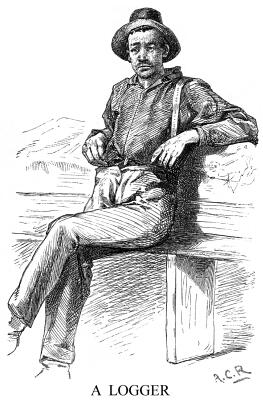 This gulch, like the other, proved
a narrow ravine, down which dashed a trout brook, where once had
grown two or three ranks of gigantic trees, the stumps remaining,
like small Martello towers, to attest their greatness of girth
and proud height. Yet these were by no means large examples, for
whereas none of the stumps here measured more than a dozen feet
across the top, specimens twice that diameter have been cut. Nor
would the latter giants be unexampled among trees. Several of
the members of the "big-tree" groves of the Sierra Nevada
surpass any example of the sempervirens ever seen; the
Douglas spruce of the mountain forests often exceeds three hundred
feet in length, and eleven hundred layers have been counted in
a Lambert pine. Such a growth of vegetable fibre, toughening through
many centuries, and rearing hundreds of cubic feet of solid substance,
excites our astonishment, and has been well defined in the phrase,
"A monument of accumulated and concentrated force." This gulch, like the other, proved
a narrow ravine, down which dashed a trout brook, where once had
grown two or three ranks of gigantic trees, the stumps remaining,
like small Martello towers, to attest their greatness of girth
and proud height. Yet these were by no means large examples, for
whereas none of the stumps here measured more than a dozen feet
across the top, specimens twice that diameter have been cut. Nor
would the latter giants be unexampled among trees. Several of
the members of the "big-tree" groves of the Sierra Nevada
surpass any example of the sempervirens ever seen; the
Douglas spruce of the mountain forests often exceeds three hundred
feet in length, and eleven hundred layers have been counted in
a Lambert pine. Such a growth of vegetable fibre, toughening through
many centuries, and rearing hundreds of cubic feet of solid substance,
excites our astonishment, and has been well defined in the phrase,
"A monument of accumulated and concentrated force."
To see the prostration of a column like that would be something
to remember; and following two men who, axe in hand, were making
their way up toward one of the larger-sized redwoods upon the
steep hill-side, we watched their attack.
"The first question, sir," said the leading axeman,
politely, "when we are going to fall a big tree, is where
she'll lay; because unless a man cares [i. e., is
careful] to fall her right, she'll break all up, and the bigger
the trunk the more liable she is to break. You can see down across
the creek there how that one snapped."
We looked where he pointed, and saw that a bole fully six feet
in diameter had broken squarely across; the brittleness of this
timber, nevertheless, is not excessive, compared with other soft
woods. Meanwhile the chopper was holding his axe in front of his
upturned face, letting it hang, head down, between his thumb and
finger, like a plummet, while he squinted past it at the top of
the tree, upon whose perfect shaft no branches grew below the
upper quarter.
"I can tell by this whether she leans out of the perpendic'lar.
If she does, you've got to allow for it; but this one don't, and
I guess, Joe, we'll drop her right along that knoll just to the
east'ard o' that oak stump—see it? But we'll have to roll
that there log out of the way a little, or she'll break her back
acrost it, sure."
Having made this simple preparation (sometimes hours are spent
in dragging logs to fill gullies, or in levelling knolls and getting
stumps out of the way), the men returned and began chopping out
some mortise-holes in the trunk about four feet above the ground.
These were intended for the insertion of their iron-shod "spring-boards"—pieces
of flexible planking about four feet long and six inches wide,
upon which they were to stand while chopping at a height too great
to reach from the ground.
The undercut was made first, and it was a fine sight to watch
these stalwart men perched upon their strips of springy board,
hurling their axe-heads deep into the gaping wound, and never
missing the precise point at which they aimed. I do not know any
attitudes more manly or motions more muscularly graceful than
those of the chopper; but perhaps the noble surroundings may count
more largely than we think in this estimate.
In about an hour the undercut had approached the heart of the
tree, and the men desisted from their work, which must now proceed
on a scientific basis.
"As I said afore," the chopper explained, "
we must fall a tree straight and true where we've fixed for it,
or else she'll go to pieces. In order to do this we've got to
measure it this way."
As he speaks he picks up from near where his coat and saw and
water caddy are lying, two sticks about four feet in length—one
a square stiff lath, the other switch-like. Going to the tree
he lays one end of the lath upon the partially exposed stump in
the undercut, its extremity resting against the heart of the wood
at the exact centre of the bole. Then stooping and sighting along
it, he moves the outer end of the lath until it points exactly
along the line where the trunk is intended to be thrown.
"Joe, go out there about a hundred feet or so and set
a stake; I want to show these gentlemen how nicely we can drive
it in with this big sledge we're goin' to let loose directly."
"Do you mean to say you will drop your tree as accurately
as that?"
"You bet—hit that stake plumb; 'n' it'll take more
mumble-te-peg 'n you're worth, I reckon, to pull it out afterward!"
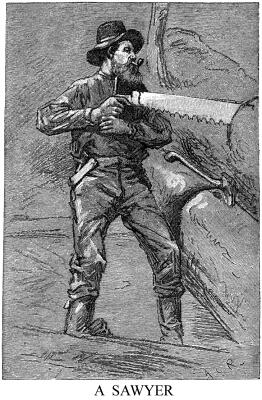 Meanwhile he went on with his
mathematics. Having aimed the lath, he measured with his switch
from its outer end to the "corner" at each side of the
undercut, and finding one side a little shorter than the other,
chopped in until he had equalized the hypothenuses of the two
right-angled triangles whose straight sides were back to back
in the line of the lath. The object and importance of this was
to make sure that the limit of the undercut, where the strain
and breakage controlling the fall of the tree (and marked by the
line of upright slivers in a stump) would finally come, should
be at right angles to the intended direction of that fall. Meanwhile he went on with his
mathematics. Having aimed the lath, he measured with his switch
from its outer end to the "corner" at each side of the
undercut, and finding one side a little shorter than the other,
chopped in until he had equalized the hypothenuses of the two
right-angled triangles whose straight sides were back to back
in the line of the lath. The object and importance of this was
to make sure that the limit of the undercut, where the strain
and breakage controlling the fall of the tree (and marked by the
line of upright slivers in a stump) would finally come, should
be at right angles to the intended direction of that fall.
"How tall do you think this tree is ?" I ask.
" Well, I should say pretty nigh on two hundred feet;
but it is easy enough to find out exactly."
Taking his axe the chopper cut a straight stake, sharpened
its end, and placed it before him while he stood very erect. Then
with his knife he cut a notch just four inches above the point
on the stake which came squarely opposite his eyes—this extra
four inches being an allowance for planting the stake in the ground.
Walking away to a point on the hill-side level with the base of
the tree, and about the right distance, as he guessed at it, he
planted the stake and lay down on his back behind it, with his
heels against its foot, and his eye trying to bring the notch
on the stake in range with the topmost plumelet of the redwood.
One or two slight shiftings of position enabled him to get this
range, and thereby to construct an equal-sided triangle. It only
remained to measure with his five-foot rule the distance from
his eyes to the base of the tree to learn the height of the tree,
representing the other side of the triangle. The fact in this
case was 180 feet.
This practical triangulation finished, the axes were laid aside,
and the spring-boards inserted in new mortises behind the tree,
and a big two-handed saw set at work to make the overcut. Soon
the crevice begins to open a little, and then a little more, until
the cautious woodmen begin to cast their eyes aloft, watching
carefully the signal that the next stroke would be the last, cutting
the one remaining tendon that holds the mighty column up, for
already there are sudden strange shivering motions in the densely
bushy thickets of foliage that adorn its lofty crown, and dead
twigs rattle down, snapped off by thrills of approaching destruction.
"Riven deep by the sharp tongues of the axes,
there in the redwood forest dense,
I heard the mighty tree its death-chant chanting.
" The choppers heard not, the camp shanties echoed not,
The quick-eared teamsters, and chain and
jackscrew men, heard not,
As the wood-spirits came from their haunts of a
thousand years to join the refrain;
But in my soul I plainly heard,
"Murmuring out of its myriad leaves,
Down from its lofty top, rising over a hundred feet high,
Out of its stalwart trunk and limbs, out of its
foot-thick bark,
That chant of the seasons and time—chant not
of the past only, but the future."
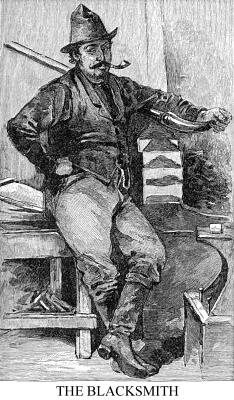 So Walt Whitman—himself
a sequoia in the forest of poets—sets to fitting music in
my grateful memory the ominous crackings of tense fibre I think
I hear, the partings of well-knit rind, and the hushed commotion
of shocked branches and crowded leafage overhead. Then comes the
final stroke of the axe, severing the last slender stay, and,
with a mingled roar and scream of frightened despair, the huge
mast, carrying all its lofty spars and well-set rigging, slowly
leans to its fate, gathers headway, spurns with giant heel the
faithless stump which hitherto has borne it proudly against every
gale and torrent, and so, stately to the last, "rustling,
crackling, crashing, thunders down." So Walt Whitman—himself
a sequoia in the forest of poets—sets to fitting music in
my grateful memory the ominous crackings of tense fibre I think
I hear, the partings of well-knit rind, and the hushed commotion
of shocked branches and crowded leafage overhead. Then comes the
final stroke of the axe, severing the last slender stay, and,
with a mingled roar and scream of frightened despair, the huge
mast, carrying all its lofty spars and well-set rigging, slowly
leans to its fate, gathers headway, spurns with giant heel the
faithless stump which hitherto has borne it proudly against every
gale and torrent, and so, stately to the last, "rustling,
crackling, crashing, thunders down."
Picking our way through the settling dust and debris of crushed
branches which lie in a thousand splinters of red and green around
the head of the prostrate chief, we look for the stake with which
Joe challenged our credulity, but fail to find it, for it has
been driven "plumb through to China," as Joe avers.
"Accidents must happen pretty often in this business,"
we remark.
"Yes, right often, both to men and animals. Sometimes
a tree is weak, and topples over before you're ready for it; or,
instead of lying still when it strikes, it sort o' picks itself
up and takes a long jump forward, which is unexpected, and liable
to hurt somebody. Then the worst of all is where the butt breaks
off and shoots back behind the stump like one o' them darned big
battering-rams you read about, and worked by sheet-lightnin' at
that. Yes, a heap of men gets killed in the woods every year.
We never had none killed dead right here, but a mighty curious
thing happened last September was a year. One of the men went
to work in the mornin' 'long with the rest—good, solid man
he was, too, with heaps of sand in him. He didn't come into dinner,
nor when night come. Then we begun to question round, and found
none of the boys had saw him since mornin'. We found his coat
and tools, but nary hide nor hair of him then nor no time afterward.
We rather looked for a sheriff to be comin' round the next day
or two, thinkin' the fellow might have got wind he was onto his
trail (though we knew nothin' agin him—but you can't 'most
always tell, you know), but none came."
" What was your conclusion as to this strange disappearance?"
"Well, we just allowed that one of these big trees had
got the drop on that fellow, as it were, and druv him clean into
the ground. Cigar? No, thank ye; I'll stick to my pipe."
The wastefulness of this lumbering is one of the striking features
of the scene. Only the largest trees are cut, those measuring
less than two feet in diameter rarely being touched, and the axe
is laid, not to the roots (though they are not thick and widely
divergent, considering the height and weight they support), but
some distance above, so that in very large specimens the massive
stump, upon whose flat top you might build a comfortable house,
stands ten or twelve feet above the ground, and contains hundreds
of feet of sound lumber, which must be left to rot or burn. Then
many trees are broken by their fall, so that large parts of them
are useless; other parts may be knotty, or crooked, or inconvenient
to drag out, and so only half of a great 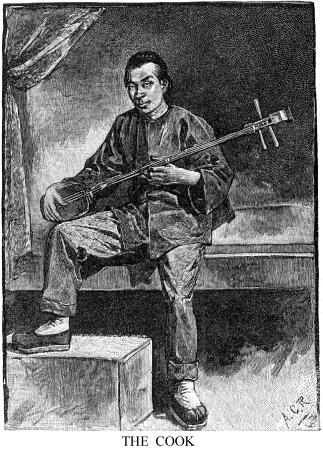 trunk
will be utilized. Huge logs are consumed, also, in road-making
and bridge-building in the hills, and dozens of small trees are
crushed by the fall of their greater companions. Then, when a
district is pretty well cleared of its best timber, fire is set
in the brush and prostrate trunks. Feeding eagerly upon the resinous
wood, half dried and broken, it gathers so much heat that the
saplings are nearly all killed, and the flaky, tinder-like bark
of the larger trees is singed in a way which must greatly injure
and often destroy them. Moreover, these fires, fanned by the gusty
breezes rushing in every afternoon from the ocean, often get beyond
control, and sweeping through the oily tops and brittle trunks,
spread blackened ruin over miles and miles of precious forest.
Precious, however, it seems never to occur to the lumberman these
forests are; yet he is probably no more wasteful and careless
here than elsewhere, and finds his match for heedless extravagance
in nearly every pursuit that deals in what nature furnished us
at the outset in abundance, but replaces only very slowly, giving
abundant leisure for our repentance. The spendthrift lumberman
is bad enough, but no worse than the wasteful oysterman or buffalohunter,
reckless of the future. It is, or ought to be, a matter of rejoicing
to everybody that the Forestry people, under Mr. Sargeant's guidance,
are paying especial attention to preserving as far as possible
the magnificent forests of the Coast Range. trunk
will be utilized. Huge logs are consumed, also, in road-making
and bridge-building in the hills, and dozens of small trees are
crushed by the fall of their greater companions. Then, when a
district is pretty well cleared of its best timber, fire is set
in the brush and prostrate trunks. Feeding eagerly upon the resinous
wood, half dried and broken, it gathers so much heat that the
saplings are nearly all killed, and the flaky, tinder-like bark
of the larger trees is singed in a way which must greatly injure
and often destroy them. Moreover, these fires, fanned by the gusty
breezes rushing in every afternoon from the ocean, often get beyond
control, and sweeping through the oily tops and brittle trunks,
spread blackened ruin over miles and miles of precious forest.
Precious, however, it seems never to occur to the lumberman these
forests are; yet he is probably no more wasteful and careless
here than elsewhere, and finds his match for heedless extravagance
in nearly every pursuit that deals in what nature furnished us
at the outset in abundance, but replaces only very slowly, giving
abundant leisure for our repentance. The spendthrift lumberman
is bad enough, but no worse than the wasteful oysterman or buffalohunter,
reckless of the future. It is, or ought to be, a matter of rejoicing
to everybody that the Forestry people, under Mr. Sargeant's guidance,
are paying especial attention to preserving as far as possible
the magnificent forests of the Coast Range.
It is interesting to observe how speedily Nature re-asserts
herself the instant the lumberman leaves her undisturbed. Every
redwood stump that escapes the fire is at once surrounded and
crowned by a dense thicket of sprouts, which in two or three years
conceal it under a cone of vivid green. Meanwhile innumerable
bushes, briers, evergreen saplings, and vines have grown up among
the many trees left standing, so that an inexperienced person,
not noting the absence of large trees, might never suspect that
the lumberman had marched through the district, sparing nothing
he cared to take, only a few months ago.
An example of this swift and pleasant renewal was a large ravine
close to the mills whither we used often to go, partly to escape
the intensely chilly wind that swept up the valley of the Russian
River during the whole month of May, but chiefly for enjoyment
of its loveliness.
This ravine was a circular basin, a quarter of a mile in width,
surrounded by hills of considerable height, forested, except at
one place where a promontory rose above the rest into a huge pile
of crimson rocks and purple heather surmounting lower slopes of
gold and green, where the long yellow plush of the turf rippled
under the wind like the surface of the river itself. Into this
basin, through a rift in the hills behind, poured a stream, expanding
into a marsh here, but a marsh so choked with flags and coarse
grass, or hidden under such a variety and luxuriance of trees
and bushes, that it was no easy matter to see any water.
From end to end of this basin, and right through its centre,
ran an old bridge or causeway, broken now and useful only for
the small foot-travel which might go that way, but plainly once
the avenue to the mill of thousands of logs, whose places the
forest had hidden so bravely that we never missed any trees out
of the still crowded ranks. Here was sketching material to last
a whole summer through—backgrounds of hills near and remote;
glimpses of white cottages to accentuate the middle distance;
trees dark and massive, with drooping boughs and pinnacled tops,
or carrying rounded, dense thickets of olive foliage far above
the hill horizon; rounded heaps of willowy bush foliage, feathery
maples, alders, and the like, some in blossom, with a foreground
of lichen-painted and flower-studded rocks, ruined platforms of
grass-grown logs, or the irregular perspective of the old causeway
making a lane straight into the heart of your composition.
As I sit watching the making of a sketch it is hard to realize
myself in California. Looking one way, I might easily think a
cypress swamp in Louisiana my hospice; looking another, any Eastern
mountain scene is duplicated, from North Carolina to the Adirondacks.
Of course a minute glance detects differences at once, but the
general impression is about the same one would gather from a wild
bit of wet woodland in the hills of any Atlantic State. Always
on the lookout for my friends the birds, I see that a stranger
would scarcely notice the difference between California and the
Catskills in this respect. The scream of woodpeckers, the short
whistle of the plumed quail—knightly bird!—the loud
click and chatter of a blazing, bee-like hummer, would excite
his question; but one hears here the same kind of melody, and
recognizes the songs of old friends in a new brogue, as is to
be expected of cousins living on this side of the big continent.
Among these low bushes, for instance, a finch is bobbing about,
chirping in a metallic manner perfectly familiar; and from another
bush comes a joyous roundelay telling me at once that it is a
song-sparrow that is the performer. The blackbirds, nestling in
the willows so well moated by the sluggish creek, carol above
their treasures in just the happy-go-lucky strain one hears in
an Ohio "swale," but, improving on it, have converted
the old cheery roulade into the sharp jingling of an armful of
small sleigh-bells. Chickadees and wrens squeak and chatter at
you, the solemn wail of the dove comes from the dark cliff, the
coarse scream of the jay (here bluer and with more swagger than
at home), and the pretty prattle of many a warbler, all suggest,
if they do not precisely tally with, the familiar bird-notes of
Eastern woods and swamps. I have heard it said that the birds
in California do not sing. It is a wicked libel. They are more
musical, on the whole, I believe, than those of the Atlantic coast,
and richer melody was never heard than drops from their happy
throats during all these sunshiny May days.
But let us return to our redwoods, and the second stage of
their degradation from trees to logs, and from logs to lumber.
The tree having been felled, men proceeded to trim away its
top, and to split off its thick coat of bark. This can often be
pried away almost without breaking it, except on top, so that
a great cast, as it were, of the trunk is left in the bark, which
lies there, after the logs are removed, like a huge ruined canoe.
I have seen masses of redwood bark fifteen inches in thickness;
the tree which it clothed, if straight and sound, would be worth
a thousand dollars. It does not follow, however, that the biggest
trunks are the most valuable, since it often happens that very
large trees prove unsound or completely hollowed.
The stripping of top branches and bark having been effected,
the trunk is sawed into logs fifteen or twenty feet in length.
A path is now cleared to them from the nearest road sufficiently
good to take in six or eight yoke of oxen. This does not require
to be a very good path either—though in some cases much labor
and rough engineering is required for these wood roads—since
the agility of the little oxen is quite wonderful when one notes
what barriers of fallen trunks and what almost vertical slopes
of hillside are surmounted. Near the lower end of the log an iron
hook, called a "dog," is driven in, where the drag-chain
is attached. Then, under a shower of such "good mouth-filling
oaths" as would have satisfied Falstaff, under resounding
thwacks and proddings of an iron-tipped goad, the slipping and
stumbling cattle snake the log endwise down the hill. But a single
log 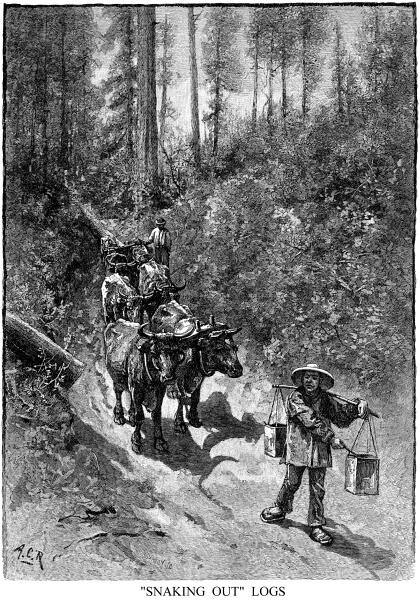 must be of extraordinary size
to content the driver. Having arranged them in line at the head
of the little gully which previous draggings have smoothed out,
he chains together two, three, even five or six logs, and starts
up the slow-moving cattle with a train behind them four or five
rods long. Though the pitches they scramble down are too smooth
and steep for us to follow, sure-footed they stay upon their legs,
and keep out of the way of the logs; thus all goes well, yet the
shouts and imprecations of the bull-whacker never cease. He curses
the logs, which are trailing along without a fault; he hurls vile
but vivid epithets at the exemplary oxen collectively and individually;
he swears at the meek Chinaman who travels ahead diligently wetting
the ground to make it slippery; he damns everything all the time,
yet is suave and polite and mild-mannered to us as we scramble
alongside, for his profanity is purely professional, and his objurgations
to be taken wholly in a Pickwickian sense. must be of extraordinary size
to content the driver. Having arranged them in line at the head
of the little gully which previous draggings have smoothed out,
he chains together two, three, even five or six logs, and starts
up the slow-moving cattle with a train behind them four or five
rods long. Though the pitches they scramble down are too smooth
and steep for us to follow, sure-footed they stay upon their legs,
and keep out of the way of the logs; thus all goes well, yet the
shouts and imprecations of the bull-whacker never cease. He curses
the logs, which are trailing along without a fault; he hurls vile
but vivid epithets at the exemplary oxen collectively and individually;
he swears at the meek Chinaman who travels ahead diligently wetting
the ground to make it slippery; he damns everything all the time,
yet is suave and polite and mild-mannered to us as we scramble
alongside, for his profanity is purely professional, and his objurgations
to be taken wholly in a Pickwickian sense.
The snaking out of these logs is another source of casualty
to the lumberman, arising not so often from the logs, however,
as from the big round butts which in many cases are sawed off
from the original trunk. These are like huge solid cart-wheels,
and of great weight: if one of them gets loose upon the steep
hill-side, whatever stops it must stand stiff and high. We were
taking breakfast with Charlie Nolan, the wide-awake foreman at
the camp, one day, Nolan sitting where he could look out of the
open door and up the mountain. Suddenly he dropped his knife,
grabbed up a small boy in each hand, and shouting, "Get out
of this!" made for the door. Nobody waited to inquire what
was the matter, but followed the injunction, turning, when the
open air was gained, just in time to see the stoppage by a firm
stump of an immense butt, which had come thundering down through
the thinned woods, aiming directly at our cottage, whose frail
walls would have offered no obstacle whatever to its progress.
Breakfast tasted much better after this escape from losing it
altogether.
The railway having been reached by the bull-team and their
train, the logs are laid lengthwise upon a sloping platform or
bank strengthened by buried skids, where a white foreman and two
or three Chinese laborers easily roll them down upon the cars,
aiding themselves with cant-hooks, jack-screws, and consonantal
expressions in two languages designed to relieve the feelings.
Having been placed upon the cars, the logs are secured by ropes
and dogs so that they can not fall, and then are taken at a break-neck
pace down to the mill, and tumbled over upon a slanting platform,
whence they can easily be rolled upon the small car which carries
them up into the mill by stationary engine-power.
The men who do this work are an interesting lot: lot,
however, if it implies that it is a collection of like articles,
is a bad word, for the striking thing about the Californian lumbermen
is their diversity, and their habit of frequently changing from
one kind of work to another, or from this camp to the next one,
in endless succession. At Duncan's camps almost every European
nationality was represented—French, German, Norwegian, Spanish,
English, Scotch, and Irish, not to speak of Americans, Chinese,
and "Indians not taxed." The Americans employed are
very often graduates of the Maine woods, or "Bluenoses"
from Lower Canada. These Maine men are likely to become foremen,
or sub-foremen, and form a nucleus around which the floating crowd
is gathered. It often happens that a man will hire himself to
labor in the redwoods who is fitted for a far better kind of work,
but has met with misfortune. You would think all of them had at
one time possessed great wealth—or at any rate had had the
opportunity of independent riches—to hear their stories;
and if you believe them all, you are more strongly than ever reminded
of the "slip 'twixt the cup and the lip" so likely to
happen. There is a kindly emulation among Californians to prove
one's self to have been more unfortunate than one's neighbor,
by magnifying the prize just missed. This is perhaps consoling
to the unfortunates, but it is confusing to the credulous historian.
It is a curious social life existing in these forest communities,
the membership of which is constantly changing, and whose scene
is annually shifted. At this camp there were only two families,
but they had nothing to do with the housing or feeding of the
sixty or more men (half Chinese), who messed by themselves, and
slept in slab shanties near by, the Chinamen having a group of
well-mottoed houses to themselves.
John Chinaman is in force here, as everywhere, for all help-work.
His slight, wiry frame, with its shoulder under the lever, shows
as much tough strength as that of his burly white neighbor, and
he grinds all day at the feed-cutter, or totes kegs of water,
balanced across his neck, up and down the rough declivities from
morning till night, without seeming to tire out or ever thinking
of a holiday. His it is also to manage the kitchen of the camp.
"John, where can we get something to eat?" we ask,
as the sun begins to send level beams between the ruddy pillars
of the soldierly sequoias.
"Heap catchum cook-house," he answers, and following
his beck, our experience shows him a capital bread-maker and beef-roaster,
but not a careful washer of dishes.
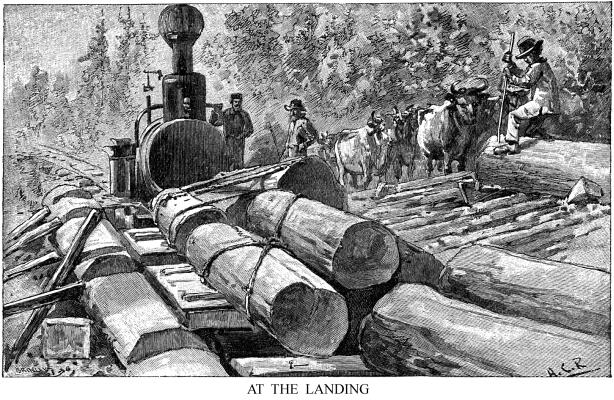 The men had gathered in the long
wooden shed for supper, eating on wooden tables, but with an abundance
of furniture and a plentiful bill of fare. Supper was hurried
through this evening, for the men had on hand a frolic which had
also the serious purpose of ridding the camp of an obnoxious old
boar that had acquired a troublesome taste for the blood of Mongolian
shanks, whose shrunken lines could ill spare the commodity. Re-enforced
with great heartiness by the Chinese contingent, the whole camp
therefore turned out on a boar hunt, assisted by several dogs
even more diverse in breed than their masters. The approved weapons
for this sort of chase, I understand, are rifles, spears, and
knives; but here were to be seen only a club or two and some ropes
looped with lassos, except that a valiant wielder of the brush
brought up the rear with a six-shooter tightly clutched in his
red right hand. The advance was not incautious. That pig had long
made himself respected to the extent that when he appeared every
man not only gave him the right of the road, but hastened to climb
upon a stump, so as to run no risk of incommoding his swineship
in the least by his presence. The men had gathered in the long
wooden shed for supper, eating on wooden tables, but with an abundance
of furniture and a plentiful bill of fare. Supper was hurried
through this evening, for the men had on hand a frolic which had
also the serious purpose of ridding the camp of an obnoxious old
boar that had acquired a troublesome taste for the blood of Mongolian
shanks, whose shrunken lines could ill spare the commodity. Re-enforced
with great heartiness by the Chinese contingent, the whole camp
therefore turned out on a boar hunt, assisted by several dogs
even more diverse in breed than their masters. The approved weapons
for this sort of chase, I understand, are rifles, spears, and
knives; but here were to be seen only a club or two and some ropes
looped with lassos, except that a valiant wielder of the brush
brought up the rear with a six-shooter tightly clutched in his
red right hand. The advance was not incautious. That pig had long
made himself respected to the extent that when he appeared every
man not only gave him the right of the road, but hastened to climb
upon a stump, so as to run no risk of incommoding his swineship
in the least by his presence.
It was not long, however, before a series of energetic grunts
was heard ahead, and the army stopped, the artist mounting a very
high stump. He said he thought they had stumbled on a bear, and
he wanted to be where he could fire over the heads of all the
men. Though only a black and bristling pig, a bear of the biggest
kind could not have held the army at bay more thoroughly. If he
had charged, I tremble to think what might have happened; but
he rushed away into the bushes and ran into a corner, where he
became the victim of strategy, and was presently bound and led
forth in degrading captivity, followed by a procession of one
artist, a score of grinning lumbermen, and a mob of chattering
and dancing Chinese, for the intention was not to kill him, but
only to eradicate his pugnacious propensities.
This done, the painter put up his pistol, and we all adjourned
to the big shanty, where some of the men pulled off their boots
and stretched themselves in restful ease upon their bunks, while
others shuffled the cards for "a little game," or did
odd jobs of tinkering.
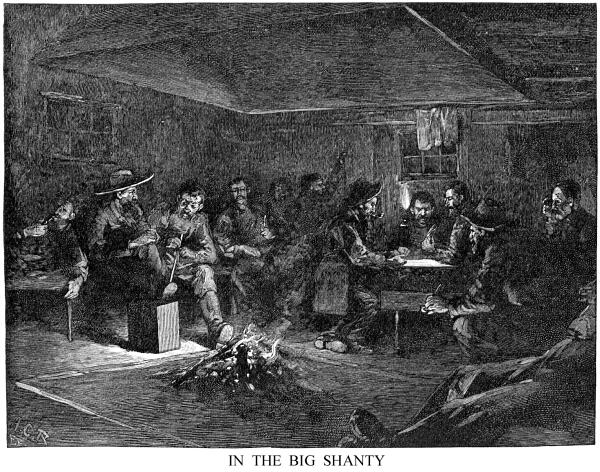 It was a strange and interesting
picture the interior of the big shanty made as the darkness of
the outside withdrew all the light from within, and left the walls
and the faces illumined only by a great fire of resinous redwood
chunks built upon a raised earthen hearth that occupied the whole
centre of the cabin, and the smoke of which escaped up a big bell-hooded
flue in the ceiling. It was a strange and interesting
picture the interior of the big shanty made as the darkness of
the outside withdrew all the light from within, and left the walls
and the faces illumined only by a great fire of resinous redwood
chunks built upon a raised earthen hearth that occupied the whole
centre of the cabin, and the smoke of which escaped up a big bell-hooded
flue in the ceiling.
The talk fell upon the enemy ignobly conquered; upon their
work, and the probable plans of "the old man," meaning
their employer; upon some men who had just departed, which carried
it away to Frisco, and drifted it upon the familiar ground of
reminiscences of the dance-house, the poker table, and the men
who were always waiting to " get the drop" on somebody,
or watching that somebody didn't get the drop on them. Stirring
stories some of them, but as unreportable as the vigorous metaphors
in which they were portrayed. Many of these men did not know the
names of their mates beyond a Sam or Jake to call them by; and
they had no especial curiosity to know, this atmosphere making
a man tender about asking his neighbor personal questions, being
shy of disturbing the pleasant status quo which rests upon careless
ignorance. Would "old Folinsbee's daughter" have enjoyed
the ball at Poverty Flat, think you, any the better for knowing
all about her partner, when she
"danced down the middle
With the man that shot Sandy McGee" ?
I think not. In California one lays his course by Mrs. Partington's
philosophy, no longer trite:
"Where ignorance is bliss,
'Twere the height of folly to be otherwise."
Down at the mills on the river, however, the men employed were
largely those having families. For these the company had built
a series of pretty cottages which were set in small gardens, kept
in neat order, and held an air of solid home comfort that was
very pleasing.
The mills here are essentially like all the rest in the redwood
belt. I had hoped to see some wonderful boards, a dozen feet broad,
cut out, but I was disappointed. If the log is of large size,
it is sent at once against a "muley," or straight rip-saw,
working perpendicularly, which splits it in two, after which the
halves are often quartered. The smaller logs and these quarters
are then hauled and rolled, with the help of steam-tackle, to
the opposite side of the building, where they are cut up by a
circular saw of large size. Lest its width should not suffice
in all cases, however, there is rigged just over the circular
saw a second one, working to meet it; between both, very wide
boards might be turned out, but it is not often done, since there
is no demand for them.
The capacity of these mills is from twenty to forty thousand feet
of lumber a day, and to them are attached planers, shingle machines,
picket headers, and so on. Next to boards, fence posts are made
in largest quantity, and after these the rough split fence pickets
so commonly used in this part of the State, the great durability
of the wood, when unpainted, recommending it for service in fences
and as roofing. Redwood shingles last like the cedar and cypress
our grandfathers chose as the thatch of those old houses whose
stability is our admiration. As this timber grows scarce it will
doubtless be applied to uses far more varied and ornamental than
at present, particularly in the way of "finishing,"
where the grain of the wood is to be preserved in view, and for
cabinet-work. The bedstead and bureaus of the room where I am
writing are made of varnished white pine, and were no doubt imported
from Michigan. The redwood treated in the same way, or by other
methods to which pine and ash are subjected, would have produced
a handsomer result, and in a more agreeable tone. I am reminded,
however, that redwood lumber for fine uses must be seasoned with
extraordinary care to save it from shrinking lengthwise—a
fault in which, I believe, it is unique.
A final day at Duncan's was spent in Azalea Gulch, just opposite,
than which nothing more lovely is hidden in the depths of the
redwood gloom. It is reached by crossing the river in a boat,
and walking through long galleries, canopied with flowers and
foliage, chiselled out of the overhanging cliff. The vale is broad
at first, with open glades carpeted in Persian pattern—the
varied greens of grasses, the sulphur dots of innumerable asters,
the purple dashes of wild pea, the warm orange of the eschscholtzia,
and the bloody stains of the wide-spread sorrel, combined in Nature's
rough loom. There are hillocks sown thick with ferns; red-stemmed,
white-crowned thickets of madroña climbing the sheltered
hillside through billows of emerald shrubbery; there are solid
pyramids of bay as impenetrable and smooth as close-cropped hedges,
or as the mossy ledge near by, where the dwarf oaks grow scraggy
and gale-bent atop; and caves of indigo darkness in the face of
the forest wall, half hidden under fringes of Spanish moss catching
silver from the sunlight. These things and more, like them and
different from them in degrees of beauty, chain the eye as you
slowly ascend the glade, hearing ceaselessly the musical splash
and gurgle of the trout water so well hidden under those dense
alders—alders like a delicate lace-work, worked in an intricate
pattern of emerald leaves and white branches and twigs; but the
strangest of all pictures is in the groves of bay; borne down
and contorted ever since they were saplings by floods in the creek,
they display the most grotesque tree forms ever seen. The trunks
become of great size (some of them are two and three feet in diameter),
but all lie prostrate, or nearly so, upon the ground, and join
together two or more tree-like growths of huge erect branches,
or arch here and there in fantastic curves which resemble nothing
so much as a crowd of huge snakes writhing about in a cave. Nor
is the impression of a cave distant from the truth. The foliage
of this tree, whenever it takes the dwarfed form, is borne only
upon the tips of the branches, that terminate in great bunches
of twigs. Each thick-crowding limb thus carries outwardly an umbrella-like
mass of leaves, through which very little light can enter; and
as here these branches are not only overhead, but are drooping
upon all sides to the very ground, a complete canopy of shade
results, unobstructed by interior twigs or foliage, through which
the fat, distorted, smooth-skinned trunks and recumbent limbs
seem to crawl and writhe in uncanny fashion.
When the glade began to narrow into a canon the redwoods appeared—magnificent
specimens standing all about the scant level of the bottom, two
by two, and rising straight two hundred feet, as though trying
to look over the hill-tops.
Between the buttresses of their great roots the soil is damp
and black, and innumerable cushions of moss hide the ledges of
rock, and feed upon the soft remains of logs half hidden in masses
of ferns and weedy vegetation-loving shade, and endless dews of
the deep coniferous woods. Half a mile further the cañon
becomes too steep and narrow for much large timber, though choked
with smaller growth; and at its head is a most picturesque cataract—a
bit of music, a flash of green and white water, a veil of glistening
verdure, and a background of splintered rocks.
Logging Page
| Contents Page
|







